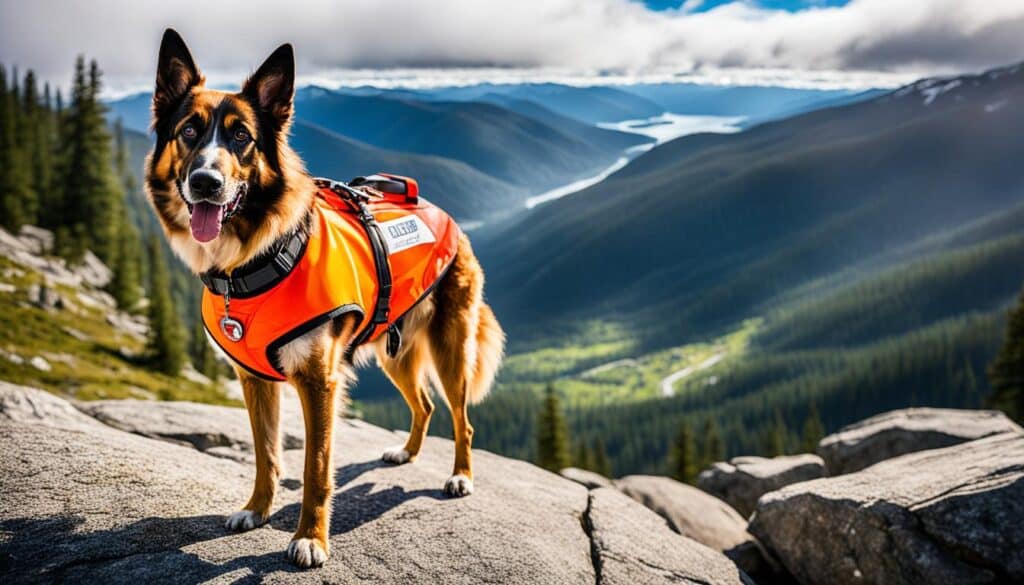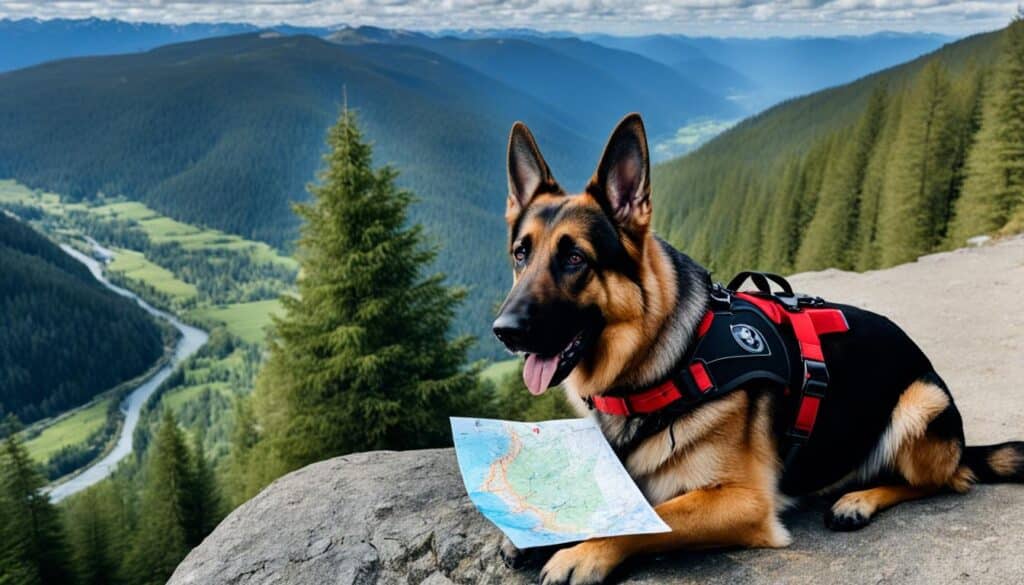Dogs are incredible creatures with a wide range of abilities, and one area where they truly excel is in search and rescue (SAR) operations. SAR dogs are specially trained to use their exceptional sense of smell to locate missing individuals and provide assistance during disasters. If you’ve ever wondered how these remarkable dogs are trained, this article will guide you through teaching your dog for SAR.

Key Takeaways:
- SAR dogs are trained to use their exceptional sense of smell to locate missing individuals and provide assistance during disasters.
- Training a SAR dog involves obedience training, introducing them to SAR concepts, and advanced techniques like scent discrimination and area search.
- The choice of breed is crucial when selecting a dog for SAR work, considering factors such as size, stamina, intelligence, and trainability.
- Certification is essential to ensure that your SAR dog is mission-ready, and organizations like the National Association for Search and Rescue (NASAR) offer comprehensive certification processes.
- Training challenges can be overcome with patience, consistency, and practical techniques while prioritizing the health and well-being of SAR dogs is essential.
The Basics of Search and Rescue (SAR): Understanding the Foundation
Search and rescue (SAR) is a crucial process that involves locating and rescuing missing or endangered individuals. It plays a vital role in saving lives and providing critical support in times of crisis. One of the key components of SAR operations is the use of highly trained search and rescue dogs.
What is SAR, and Why is it Important?
SAR is the organized effort to find, aid, and evacuate individuals who are lost, injured, or at risk in various environments. It encompasses a range of scenarios, including natural disasters, wilderness emergencies, and urban search operations. The importance of SAR cannot be overstated, as it directly impacts the survival and well-being of those in need.
Key Characteristics of a Search and Rescue Dog
SAR dogs possess several essential characteristics that make them well-suited for their important role. They are known for their remarkable agility, intelligence, and, most notably, their exceptional sense of smell. A SAR dog’s keen olfactory abilities enable them to detect and locate scents that humans would not even perceive. These characteristics allow SAR dogs to track and find missing individuals in various environments effectively.
Overview of the Training Process for SAR Dogs
SAR dogs undergo rigorous training to develop the skills for successful search and rescue operations. The training typically begins with basic obedience training, where dogs learn essential commands and proper behavior. They are then gradually introduced to SAR concepts, such as tracking scents and following trails. Advanced training techniques, such as scent discrimination and area search, further enhance their abilities and prepare them for real-life SAR missions.
SAR dogs work closely with their handlers during the training process to develop a strong bond and effective communication. This partnership is crucial for achieving optimal results in search and rescue operations.

Choosing the Right Breed for SAR Work
The choice of breed plays a critical role in selecting a dog for search and rescue (SAR) work. Different breeds possess varied characteristics and abilities that make them suitable for specific tasks in SAR operations. When choosing a breed for SAR work, several factors must be considered, including size, stamina, intelligence, and trainability.
Why Breed Matters in SAR Operations
The breed of a SAR dog significantly impacts its performance in SAR operations. Each breed has unique traits that can enhance or hinder its ability to fulfill the demanding tasks required in search and rescue missions. For example, certain breeds may excel in tracking scents over long distances, while others may possess greater agility for navigating challenging terrains.
Top Breeds for Search and Rescue Work
While there are several breeds capable of excelling in SAR work, some top choices have consistently demonstrated their effectiveness in search and rescue operations:
- German Shepherds: Known for their intelligence, trainability, and versatility, they are frequently employed in SAR operations. Their strong work ethic, agility, and exceptional scenting ability make them ideal for tracking and locating missing individuals.
- Labrador Retrievers: Labrador Retrievers are renowned for their friendly nature, intelligence, and excellent nose work. They possess a keen sense of smell, making them adept at detecting scents, including those from buried or hidden sources.
- Belgian Malinois: Belgian Malinois are highly regarded for their intelligence, athleticism, and unwavering focus. Their exceptional drive and agility enable them to navigate various environments and perform specialized tasks such as building searches and apprehensions.
Understanding the Physical and Mental Requirements for SAR Dogs
Aside from breed characteristics, SAR dogs must meet specific physical and mental requirements to excel in their work. These include:
- Good physical condition: SAR dogs must be fit and agile to endure long hours of searching and navigating challenging terrains without fatiguing quickly.
- High energy levels: SAR dogs must possess a surplus of energy to sustain their focus and perseverance during extended search operations.
- Ability to focus and work in challenging environments: SAR dogs must maintain attention to detail and remain focused in high-stress situations, even in adverse weather conditions or disaster-stricken areas.
By carefully considering the breed’s characteristics and ensuring that the dog meets the physical and mental requirements, search and rescue teams can select dogs with the necessary traits to excel in SAR operations.
Step-by-Step Guide to Training Your Dog for SAR
Training a search and rescue (SAR) dog requires a structured and systematic approach. Following a step-by-step guide, you can ensure your dog receives the necessary training to excel in SAR operations.
Basic Obedience: The Foundation of SAR Training
Basic obedience training is the starting point for any SAR dog. This foundation gives your dog the necessary skills and discipline to perform effectively in search and rescue missions. Some critical aspects of basic obedience training include:
- Teaching essential commands like sit, stay, and come
- Improving leash manners and proper socialization
- Building focus and responsiveness to commands
By mastering these basic obedience skills, your dog will have a solid foundation to build upon as they progress in their SAR training.
Introducing Your Dog to SAR Concepts
Once your dog fully understands basic obedience, it’s time to introduce them to SAR concepts. This step helps familiarize your dog with the specific tasks and techniques they will encounter during SAR missions. Some important aspects of introducing SAR concepts include:
- Teaching your dog to search for human scent
- Introducing them to tracking and trailing exercises
- Developing their ability to follow trails and locate missing individuals.
Exposing your dog to these SAR concepts lays the groundwork for their advanced training and real-life SAR missions.

Advanced Training Techniques: Scent Discrimination and Area Search
Once your dog has a solid foundation in basic obedience and has been introduced to SAR concepts, it’s time to take their training to the next level. Advanced training techniques focus on enhancing their search abilities and preparing them for demanding SAR operations. Some advanced training techniques for SAR dogs include:
- Scent discrimination: Training your dog to identify and differentiate specific scents, helping them locate individuals even in complex environments.
- Area search: Teach your dog to systematically search large areas, using their scenting abilities to pinpoint missing individuals’ locations.
By incorporating these advanced techniques into your SAR dog’s training regimen, you are equipping them with the skills to be effective search and rescue companions.
Following this step-by-step guide to training your dog for SAR, you can ensure they are prepared and ready to contribute to search and rescue operations. From basic obedience to advanced techniques, each stage of training is crucial in developing your dog’s skills and abilities.
Getting Certified: How to Ensure Your SAR Dog is Mission-Ready
Certification is an essential step in ensuring that your SAR dog is mission-ready. It verifies that the dog and handler have met specific standards and are prepared to work effectively in search and rescue operations.
Understanding SAR Certification Requirements
Each certification organization may have specific requirements that dogs and handlers must meet. These requirements are designed to assess the skills, training, and capabilities of SAR teams. They typically include evaluations of obedience, search skills, agility, and response to various scenarios.
The Path to NASAR Certification for You and Your Dog
The National Association for Search and Rescue (NASAR) offers a comprehensive certification process for dogs and handlers. Their program includes multiple levels of certification, allowing teams to progress as they gain experience and expertise. NASAR certification provides recognition and credibility within the SAR community.
Participating in Mock Searches and Joining SAR Teams
Participating in mock searches is an essential part of the certification process. Mock searches simulate real-life scenarios and provide valuable training opportunities for SAR dogs and their handlers. These exercises help teams practice their skills, refine their techniques, and build confidence.
Joining a SAR team is another critical step in the certification journey. SAR teams provide a supportive community and valuable resources for training and deploying SAR dogs. They offer opportunities to work alongside experienced handlers, learn from their expertise, and gain practical knowledge in real-world search and rescue operations.
Challenges and Solutions in SAR Dog Training
Common Training Challenges and How to Overcome Them
Training a search and rescue (SAR) dog can present various challenges that handlers must overcome to ensure adequate training. Some common challenges include distractions, scent contamination, and maintaining motivation during training sessions. Distractions can disrupt the dog’s focus and concentration, making it challenging to execute commands and follow scent trails accurately. To address this, handlers must gradually introduce distractions during training, starting with mild distractions and progressively increasing the difficulty level. This helps the dogs develop the ability to stay focused in distracting environments.
Scent contamination is another challenge that SAR dogs may encounter during training. It occurs when scents overlap in a search area, making it difficult for the dog to distinguish the target scent. Handlers can practice scent discrimination exercises with their dogs to overcome this challenge. These exercises involve introducing the dog to various scents and teaching them to differentiate between odors. This helps the dog develop the ability to focus on the target scent and ignore distractions.
Maintaining motivation during training sessions is essential for SAR dogs to perform effectively. It can be challenging to keep dogs motivated, especially during repetitive training exercises. Handlers can overcome this challenge by using positive reinforcement techniques, such as rewards and praise, to keep the dogs engaged and motivated. They can also incorporate variety into training sessions by including different search scenarios and tasks to keep the dogs mentally stimulated and eager to work.
Maintaining the Health and Well-being of Your SAR Dog
The health and well-being of SAR dogs are of utmost importance to ensure their optimal performance in search and rescue operations. Handlers should prioritize the following aspects of their dog’s health:
- Nutrition: Providing a balanced diet that meets the specific nutritional needs of SAR dogs is essential. High-quality dog food that supports energy levels, muscle development, and overall health is recommended.
- Exercise: Regular exercise is vital for maintaining the physical fitness and stamina of SAR dogs. Handlers should provide ample exercise opportunities, including mental and physical stimulation.
- Veterinary Care: Routine veterinary check-ups, vaccinations, and preventive treatments are necessary to ensure the well-being of SAR dogs. Regular health monitoring and addressing any medical issues promptly are essential.
Building a Strong Handler-Dog Relationship for Effective SAR Work
The relationship between a handler and a SAR dog is crucial for successful search and rescue operations. Building a strong bond based on trust and effective communication is critical to working effectively as a team. Here are some essential steps to foster a strong handler-dog relationship:
- Positive Reinforcement: Using positive reinforcement techniques to reward desired behaviors helps strengthen the bond between the handler and the dog. Rewards can include treats, praise, or playtime.
- Consistency: Consistency in training methods and commands helps establish clear expectations for the dog. Handlers should be consistent in their approach and avoid confusing the dog with conflicting signals.
- Regular Training Sessions: Consistently engaging in training sessions helps strengthen the bond between the handler and dog and maintain the dog’s skills and performance level.
- Quality Time: Spending quality time together outside training sessions, such as playing or relaxing, helps foster a strong emotional connection between the handler and the dog.
Real-World Applications: SAR Dogs in Action
SAR dogs have proven invaluable assets in real-life rescue operations, showcasing their remarkable abilities and unwavering dedication. Their inspiring stories and successful rescues testify to their work’s importance and impact. These extraordinary canines have played essential roles in providing aid and support during natural disasters and humanitarian efforts worldwide, profoundly impacting the lives they touch.
Inspiring Stories of SAR Dogs and Their Rescues
Countless stories of SAR dogs going above and beyond in their duty have captivated people’s hearts worldwide. From locating missing individuals trapped under collapsed buildings to finding lost hikers in remote wilderness, SAR dogs have proved to be heroes. These inspiring tales highlight their exceptional training, intuition, and the strong bond they share with their handlers. Through their courageous actions, SAR dogs bring hope and comfort to those in desperate situations, putting a spotlight on their extraordinary capabilities as lifesavers.
The Role of SAR Dogs in Natural Disasters and Humanitarian Efforts
When natural disasters strike or humanitarian crises unfold, SAR dogs take action with unparalleled readiness and determination. Their exceptional scent detection abilities, agility, and resilience enable them to locate survivors in the most challenging conditions. SAR dogs have been crucial in finding people buried under debris, rescuing victims trapped by floods or avalanches, and providing much-needed emotional support to those affected by tragic events. Their involvement in humanitarian efforts and disaster relief operations has saved countless lives and given hope to devastated communities.
The Future of Search and Rescue Operations: Technology and Canine Partners
The future of search and rescue operations is continuously evolving, leveraging advancements in technology and the integration of canine partners. Drone technology, GPS tracking systems, and thermal imaging are harnessed to enhance search capabilities, making SAR missions more efficient and effective. Furthermore, researchers are exploring innovative ways to improve the training and performance of SAR dogs, including using scent detection devices and specialized communication systems. The collaboration between technology and the exceptional skills of SAR dogs holds excellent promise, ensuring that search and rescue operations can adapt to emerging challenges and continue to save lives.
FAQs
Q: What are the first steps to train my dog to search and rescue?
A: Basic obedience is essential before advancing to more specialized SAR training. Your dog should master commands such as stay, come, and heel, especially off-leash, as dogs work off-leash during search operations. Then, introducing your dog to scent training early on helps to develop its tracking abilities, which is crucial for finding missing persons. Getting involved with a local search and rescue team or finding a certified search dog trainer can provide you with guidance and a structured training program.
Q: How can I get my dog certified for search and rescue operations?
A: To get your dog certified, you must complete a training program through a recognized dog association that evaluates search and rescue dogs. This involves hours of training and passing a series of tests that assess the dog’s ability to find people, follow commands, and work under different conditions. Joining a k9 sar team or sar group can provide access to resources and training opportunities to help prepare your dog for certification tests.
Q: Are certain dog breeds more suited for SAR work?
A: While many dog breeds have the potential to become effective search dogs, breeds with solid work ethics, intelligence, and physical endurance tend to excel. Breeds such as German Shepherds, Belgian Malinois, Border Collies, and Labrador Retrievers are among the top choices. However, the dog’s temperament, eagerness to learn, and ability to work as part of a team are more critical than the breed alone.
Q: How can I help my dog find people during training?
A: To help your dog learn how to find people, start with simple exercises that gradually increase in complexity. Use games like hide and seek to teach your dog to use its nose to locate people. Reward the dog generously when it finds someone to reinforce the behavior. As the dog progresses, incorporate more realistic scenarios that mimic actual search and rescue conditions, teaching the dog to navigate various terrains and weather conditions while focusing on the search.
Q: What are the challenges of training a dog for SAR work?
A: One of the main challenges is ensuring that the dog stays committed and focused during long, often physically demanding searches. The dog must learn to work off-leash, navigate rugged terrains, and deal with distractions without losing track of its goal. It’s also crucial for the handler to learn how to read the dog’s signals accurately, as the dog cannot verbally communicate when it finds something. Financial and time commitments can also pose significant challenges, as becoming part of a search and rescue dog team requires much dedication and hours of training.
Q: How can joining a local search and rescue team benefit my training process?
A: Joining a local search and rescue team provides you and your dog access to experienced trainers and dog handlers who can offer valuable advice and feedback. It also allows your dog to train in realistic scenarios, interact with other trained dogs, and participate in mock search operations. Being part of a team can help your dog become accustomed to working alongside other dogs and people, a crucial aspect of search and rescue operations. Additionally, SAR groups often have resources and connections to help get your dog certified.
Q: What should I do if my dog isn’t suited for SAR work?
A: If your dog shows signs that it isn’t suited for search and rescue work, like lacking interest in scent training or struggling with the physical demands, it’s essential to acknowledge that not all dogs are cut out for this type of work. Dogs not suited for SAR can excel in other areas, such as agility, obedience, or even therapy work. Focusing on activities that align with your dog’s strengths and preferences is essential, ensuring a happy and fulfilling life for both the dog and the handler.

